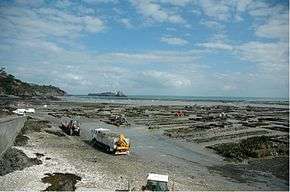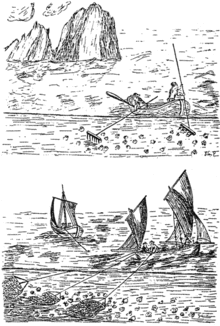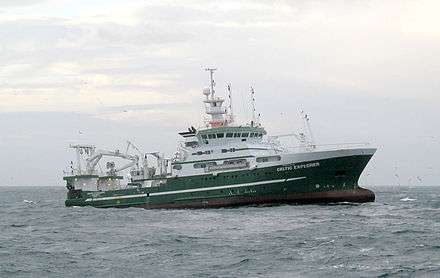Oyster farming
Oyster farming is an aquaculture (or mariculture) practice in which oysters are raised for human consumption. Oyster farming was practiced by the ancient Romans as early as the 1st century BC on the Italian peninsula[1] and later in Britain for export to Rome. The French oyster industry has relied on aquacultured oysters since the late 18th century.[2]
History
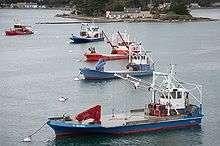


Oyster farming was practiced by the ancient Romans as early as the 1st century BC on the Italian peninsula.[3] With the Barbarian invasions the oyster farming in the Mediterranean and the Atlantic came to an end.
In 1852 Monsieur de Bon started to re-seed the oyster beds by collecting the oyster spawn using makeshift catchers. An important step to the modern oyster farming was the oyster farm built by Hyacinthe Boeuf in the Ile de Ré. After obtaining the rights to a part of the coast he built a wall to make a reservoir and to break the strength of the current. Some time later the wall was covered with spat coming spontaneously from the sea which gave 2000 baby oysters per square metre.[4]
Varieties of farmed oysters
Commonly farmed food oysters include the Eastern oyster Crassostrea virginica, the Pacific oyster Crassostrea gigas, Belon oyster Ostrea edulis, the Sydney rock oyster Saccostrea glomerata, and the Southern mud oyster Ostrea angasi.
Cultivation
Oysters naturally grow in estuarine bodies of brackish water. When farmed, the temperature and salinity of the water are controlled (or at least monitored), so as to induce spawning and fertilization, as well as to speed the rate of maturation – which can take several years.
Three methods of cultivation are commonly used. In each case oysters are cultivated to the size of "spat," the point at which they attach themselves to a substrate. The substrate is known as a "cultch" (also spelled "cutch" or "culch").[5] The loose spat may be allowed to mature further to form "seed" oysters with small shells. In either case (spat or seed stage), they are then set out to mature. The maturation technique is where the cultivation method choice is made.
In one method the spat or seed oysters are distributed over existing oyster beds and left to mature naturally. Such oysters will then be collected using the methods for fishing wild oysters, such as dredging.
In the second method the spat or seed may be put in racks, bags, or cages (or they may be glued in threes to vertical ropes) which are held above the bottom. Oysters cultivated in this manner may be harvested by lifting the bags or racks to the surface and removing mature oysters, or simply retrieving the larger oysters when the enclosure is exposed at low tide. The latter method may avoid losses to some predators, but is more expensive.[6]
In the third method the spat or seed are placed in a cultch within an artificial maturation tank. The maturation tank may be fed with water that has been especially prepared for the purpose of accelerating the growth rate of the oysters. In particular the temperature and salinity of the water may be altered somewhat from nearby ocean water. The carbonate minerals calcite and aragonite in the water may help oysters develop their shells faster and may also be included in the water processing prior to introduction to the tanks. This latter cultivation technique may be the least susceptible to predators and poaching, but is the most expensive to build and to operate.[7] The Pacific oyster C. gigas is the species most commonly used with this type of farming.
 Oyster culture using tiles as cultch. Taken from The Illustrated London News 1881
Oyster culture using tiles as cultch. Taken from The Illustrated London News 1881- Purpose made oyster baskets

- Oyster farm in South Australia
- Oyster shucking at Lau Fau Shan, Hong Kong
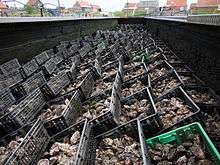
Boats
During the nineteenth century in the United States, various shallow draft sailboat designs were developed for oystering in Chesapeake Bay. These included the bugeye, log canoe, pungy, sharpie and skipjack. During the 1880s, a powerboat called the Chesapeake Bay deadrise was also developed.
Since 1977, several boat builders in Brittany have built specialized amphibious vehicles for use in the area's mussel and oyster farming industries. The boats are made of aluminium, are relatively flat-bottomed, and have three, four, or six wheels, depending on the size of the boat. When the tide is out the boats can run on the tidal flats using their wheels. When the tide is in, they use a propeller to move themselves through the water. Oyster farmers in Jersey make use of similar boats. Currently, Constructions Maritimes du Vivier Amphibie has a range of models.[8]
Environmental impact
The farming of oysters and other shellfish is relatively benign or even restorative environmentally, and holds promise for relieving pressure on land-based protein sources.[9] Restoration of oyster populations are encouraged for the ecosystem services they provide, including water quality maintenance, shoreline protection and sediment stabilization, nutrient cycling and sequestration, and habitat for other organisms.[10] A native Olympia oyster restoration project is taking place in Liberty Bay, Washington,[11] and numerous oyster restoration projects are underway in the Chesapeake Bay.[12] In the U.S., Delaware is the only East Coast state without oyster aquaculture, but making aquaculture a state-controlled industry of leasing water by the acre for commercial harvesting of shellfish is being considered.[13] Supporters of Delaware's legislation to allow aquaculture cite revenue, job creation, and nutrient cycling benefits. It is estimated that one acre can produce nearly 750,000 oysters, which could filter between 15 and 40 million gallons of water daily.[13]
Other sources state that a single oyster can filter 24–96 liters a day(1–4 liters per hour).[14] With 750,000 oysters in one acre, 18,000,000-72,000,000 liters of water can be filtered, removing most forms of particulate matter suspended in the water column. The particulate matter oysters remove are sand, clay, silt, detritus, and phytoplankton.[14] These particulates all could possibly contain harmful contamination that originates from anthropogenic sources (the land or directly flowing into the body of water).[15] Instead of becoming ingested by other filter feeders that are then digested by bigger organisms, oysters can sequester these possibly harmful pollutants, and excrete them into the sediment at the bottom of waterways.[14] To remove these contaminants from the sediment, species of seaweed can be added to take up these contaminants in their plant tissues that could be removed and taken to a contained area where the contamination is benign to the surrounding environment.[16]
Predators, diseases and pests
Oyster predators include starfish, oyster drill snails, stingrays, Florida stone crabs, birds, such as oystercatchers and gulls, and humans.
Pathogens that can affect either farmed C. virginica or C. gigas oysters include Perkinsus marinus (Dermo) and Haplosporidium nelsoni (MSX). However, C. virginica are much more susceptible to Dermo or MSX infections than are the C. gigas species of oyster.[17] Pathogens of O. edulis oysters include Marteilia refringens and Bonamia ostreae.[18] In the north Atlantic Ocean, oyster crabs may live in an endosymbiotic commensal relationship within a host oyster. Since oyster crabs are considered a food delicacy they may not be removed from young farmed oysters, as they can themselves be harvested for sale.
Polydorid polychaetes are known as pests of cultured oysters.[19]
See also
References
- ↑ James Arnold Higginbotham, Piscinae: artificial fishponds in Roman Italy (University of North Carolina Press, 1997), p. 247, note 44 online; Cynthia J. Bannon, "Servitudes for Water Use in the Roman Suburbium," Historia 50 (2001), pp. 47–50. For more on these early efforts, see Sergius Orata.
- ↑ Kurlansky, pg. 49
- ↑ Higginbotham, James Arnold (1997-01-01). Piscinae: Artificial Fishponds in Roman Italy. UNC Press Books. ISBN 9780807823293.
- ↑ Toussaint-Samat, Maguelonne (2009-03-25). A History of Food. John Wiley & Sons. ISBN 9781444305142.
- ↑ Myer, Rolla (Oct–Dec 1948), "Oyster Terms in the Puget Sound Region", American Speech, The American Dialect Society, 23 (3/4): 296–298, doi:10.2307/486938, JSTOR 486938
- ↑ "Oyster Farming in Louisiana" (PDF). Louisiana State University. Retrieved 2012-10-01.
- ↑ "Korea-Us Aquaculture". Retrieved 2008-08-08.
- ↑ Company website
- ↑ "The Case for Fish and Oyster Farming," Carl Marziali, University of Southern California, May 17, 2009.
- ↑ The Nature Conservancy. "Shellfish Reefs at Risk: Critical Marine Habitats".
- ↑ "Recovery of the Olympia Oyster in Kitsap County". USDA Natural Resources Conservation Service.
- ↑ Chesapeake Bay Foundation. "RESTORE - Oyster Restoration". Retrieved May 18, 2012.
- 1 2 Brown, Ashton (June 10, 2013). "'Aquaculture' shellfish harvesting bill moves forward". Delaware State News. Retrieved June 11, 2013.
- 1 2 3 Rice, M.A.(2000). Environmental Impacts of Shellfish Aquaculture: Filter Feeding to Control Eutrophication. Environment Cape Cod. 1(1) 77-86.
- ↑ A H Buschmann, M C Herna´ndez-Gonza´ lez, C Aranda, T Chopin, A Neori, C Halling, andM Troell. Mariculture Waste Management. In Sven Erik Jørgensen and Brian D. Fath(Editor-in-Chief), Ecological Engineering. Vol. [3] of Encyclopedia of Ecology,5 vols. [2211-2217]
- ↑ Neori, A., Chopin, T., Troell, M., Buschmann, A., Kraemer, G., Halling, C., Shpigel, M. and Yarish, C. (2004). Integrated aquaculture: rationale, evolution and state of the art emphasizing seaweed bio filtration in modern mariculture. Aquaculture, 231(1-4), pp.361-391.
- ↑ Goedken, Michael; Brenda Morsey; Inke Sunila; Sylvain De Guise (August 2005). "Immunomodulation of Crassostrea gigas and Crassostrea virginica cellular defense mechanisms by Perkinsus marinus". Journal of Shellfisheries Research.
- ↑ "FAO Fisheries & Aquaculture Ostrea edulis". FOOD AND AGRICULTURE ORGANIZATION OF THE UNITED NATIONS. Retrieved 2008-08-06.
- ↑ Simon, C.A. 2011. Polydora and Dipolydora (Polychaeta: Spionidae) associated with molluscs on the south coast of South Africa, with descriptions of two new species. African Invertebrates 52 (1): 39-50.
Further reading
- Kurlansky, Mark (2006). The Big Oyster: History on the Half Shell. New York: Ballantine Books. ISBN 978-0-345-47638-8.
- Ingersoll, Ernest (1881). The Oyster Industry. United States Government Printing Office. LCCN 12034550.
External links
- The Oystermen Documentary produced by Oregon Public Broadcasting
| Wikisource has original text related to this article: |
![]() Media related to Oyster culture at Wikimedia Commons
Media related to Oyster culture at Wikimedia Commons
